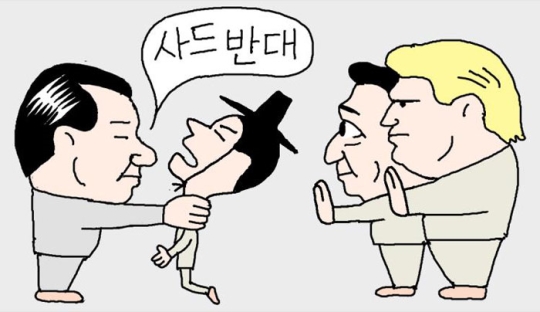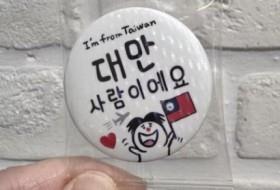“中国对萨德的激愤是无凭无据的。对本国构成战略威胁的主张更是极尽夸张。中国对部署在邻国日本的萨德不置可否。美国海军在宙斯盾导弹驱逐舰上也配备了与萨德基本相同的系统。且该驱逐舰与部署在韩国的固定萨德不同,随时都可以接近中国大陆,但中国对此并未做出回应。
与其同时,中国还不故意理会韩国部署萨德纯碎是为了拦截朝鲜弹道导弹的事实。在这样的关头,我们有必要分析一下中国的精神状态,以助于理解为何会产生这类的战略观点。
中国的过激反应是沉醉于自己制造的战略空想所导致的结果。中国怀疑美国有意制造紧张局势,意图推翻朝鲜政权,有预谋地完成对中国的包围。
中国的愤怒同时也反映出了对待周边国家的‘汉族国粹主义’。真正部署与运营萨德的主体是美国,却只对韩国施压的背后是‘你们一个小国胆敢违抗大国之意?’的心理。随着中国经济与军事实力的增强,‘大国vs小国’的外交愈发露骨化。中国一天不放弃追求大国优越主义的中华思想,东北亚则一日不得安宁。” 胡佛研究所得出的结论是,中国采取单方面萨德报复措施是因为将韩国视为“卒”。
美国智库胡佛研究所原文:
Deciphering China’s Rage At South Korea
by Miles Maochun Yu
Wednesday, March 15, 2017
China is mad—really mad—at South Korea. Well-known Chinese defense and military figures are advocating direct military strikes against South Korea; state-controlled media are fanning anti-Seoul hysteria; mobs across the country are smashing South Korean-made goods and merchandise; K-pop concerts and other South Korean cultural events long on the schedule are being cancelled without explanation; South Korea-bound Chinese tourists are forced to cancel their flights and cruise tickets; many South Korean stores and companies in China are harassed and restricted by local authorities, and some are forced to close their shops.
Ostensibly the reason for China’s anger is the deployment in South Korea of the U.S. Army’s Terminal High Altitude Area Defense (THAAD) missile interception system to destroy incoming North Korean ballistic missiles. China interprets this action as a threat to deterrence.
Beijing’s rage over THAAD is unfounded because the system’s strategic threat to China’s missile deterrence is grossly exaggerated to say the least. Such reaction from China blatantly denies the real ballistic missile threats from North Korea against the South and the interests of the United States in the region.
China acts as if THAAD is new and its capabilities will completely nullify China’s fast- developing missile programs. In fact, THAAD, which may also soon be deployed in nearby Japan, is but one of the several missile-defense systems South Korea and its allies the United States and Japan could use to achieve the same purpose. Besides the U.S. Army’s THAAD system, the U.S. Navy has a nearly identical system installed on its large fleet of Arleigh Burke-class Aegis guided missile destroyers, which could be deployed even closer to China and more flexibly than the U.S. Army’s THAAD. U.S. military authorities have utilized all of their persuasive options and consultative channels to try to explain to Beijing that THAAD is strictly for use against North Korean missiles and poses no technical or strategic threats to Beijing’s missile deterrence. But Beijing stubbornly refuses to listen to reason and continues the THAAD red herring.
To understand China’s temper tantrum, one must go beyond THAAD and delve into China’s deeper psyche that speaks volumes about China’s strategic views and peculiar gamesmanship. First, China’s indignation is a result of incurable intoxication with a strategic fantasy of its own making, namely that the United States is deliberately stirring up tensions on the Korean Peninsula so that Washington can destroy the North Korean regime and complete a strategic encirclement of China. According to such a theory, Kim Jong-un’s belligerent behavior, like that of his father’s and grandfather’s, is not the source of the tensions but only the response to the root of the tensions in the Korean Peninsula, namely the constant provocations and military buildup and drills by the U.S. and its ally South Korea. As Pyongyang’s only ally, China can be annoyed by Kim’s rash and bratty aggressiveness in pushing ahead with its nuclear and missile programs, but ultimately China is unwilling to join the rest of the world to stop Kim’s dangerous gambits, continuing to support the regime through open and furtive economic assistance and trade.
Second, China’s rage reflects its Han chauvinism toward its neighbors in the periphery. It seems odd that China is thoroughly mad at South Korea but not directly chastising the United States that is actually installing and operating the THAAD system. That is because China considers South Korea a small country [xiaoguo] that should not have the chutzpah to defy a big country [daguo] such as China. This xiaoguo vs. daguo complex is becoming a hallmark of Chinese diplomacy in recent decades as China grows economically and militarily stronger.
For about four years since 2012, China’s leadership believed they had successfully split the U.S.-led defense alliance in Northeast Asia, pitting South Korea against Japan, thus isolating the U.S. Convinced of China’s willingness to rein in the Kim regime, former president Park Geun-hye of South Korea unwisely sided with China against Japan in the Beijing-Tokyo spat over a variety of issues, threatening the unity of the U.S.-led alliance. But China’s outrageous snub of President Park in January 2016 by refusing to respond to Seoul’s call for joint action against Kim’s renewed nuclear and missile tests catapulted South Korea back to the camp of the U.S. and Japan, which was viewed by Beijing as perfidious and disrespectful of the magnificent and magnanimous daguo that is China. President Park’s approval of the THAAD deployment is thus just a matter of China’s revenge and punitive rant against the little xiaoguo on the Korean Peninsula.
Unless China abandons its decades-old misguided siege mentality and its centuries-old daguo chauvinism, regional security in Northeast Asia will not fundamentally improve, with or without THAAD deployment.





.jpg)
.jpg)
.jpg)


.jpg)
.jpg)

.jpg)
.jpg)
